| |
New CDC HCV Acute, Chronic & Deaths in USA: doubled acute cases;
death rates highest among 55-74 year-olds
|
| |
| |
New CDC Viral Hepatitis Reports on US Surveillance in 2021 and on Progress [what progress? There is none !] Toward Reaching National Elimination Goals
https://www.hiv.gov/blog/new-cdc-viral-hepatitis-reports-on-us-surveillance-in-2021-and-on-progress-toward-reaching-national-elimination-goals/?utm_source=email&utm_medium=email&utm_campaign=Daily20230816
The Centers for Disease Control and Prevention (CDC) has published the Viral Hepatitis Surveillance Report— United States, 2021 and the 2023 Viral Hepatitis National Progress Report. These reports contain hepatitis A, hepatitis B, and hepatitis C surveillance
Hepatitis C-associated death rates were highest among persons aged 55-74 years, compared with other age categories, and deaths in this age group accounted for 75% of all hepatitis C-associated deaths reported during 2021.
the death rates among non-Hispanic American Indian/Alaska Native persons (9.99 deaths per 100,000 population) and non-Hispanic Black persons (5.01 deaths per 100,000 population) were 3.4 times and 1.7 times the rate among non-Hispanic
White persons, respectively. Variations of disease rates by race or ethnicity may reflect systemic cultural, behavioral, environmental, and social factors, including structural racism. The highest hepatitis C-associated death rate was reported in US Department of Health and Human Services Region 10 (Alaska, Idaho, Oregon, and Washington), compared with other regions.
"Its getting worse with increasing new acute HCV infections being reported & increasing rates of perinatal transmission. Death rates highest among 55-74 yr olds tell us many people are NOT getting screened & linked to care & treated !"" Jules
"Persistent, Ongoing New Cases, New Chronic & Acute Cases, Persistently High Death Rates, Perinatal Transmission Rates, Racial Inequities for Black & Latinos, and Indian/Alaska Natives". Jules Levin
"Will the White House Initiative to fund HCV elimination success in getting funding from Congress? We don't know but the effort is ongoing. Without adequate funding for a comprehensive well planned project national in scope this is what will continue - Continued HCV Infections & Deaths for a curable disease, with 8-12 weeks tolerable, safe & inexpensive therapy (direct acting antivirals; DAAs) that show close to 100% cure rates, which would save billions of dollars in health care costs & save lives- if we had a national elimination program." Jules
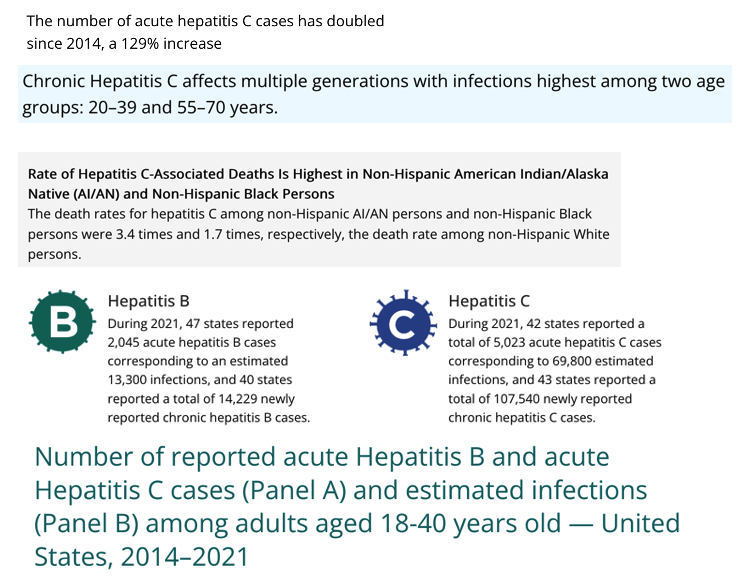
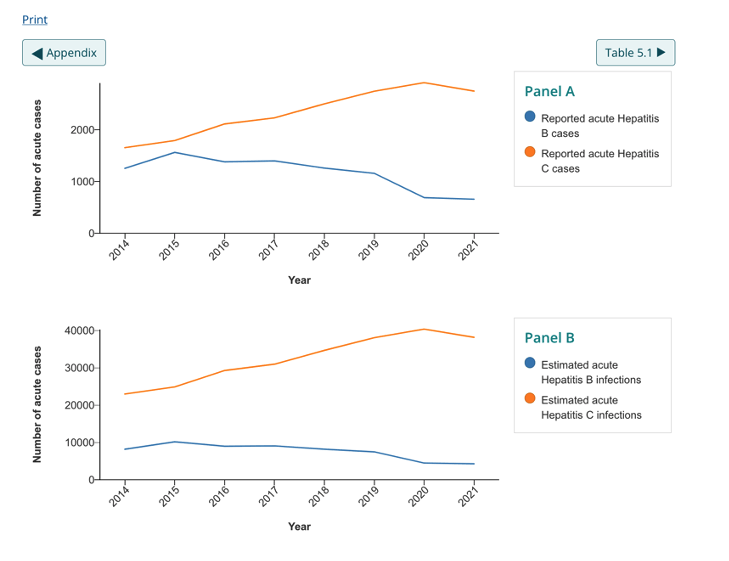
• Rates of acute HCV have consistently been lowest among those aged less than 20 years or 60 years and older; however, rates have been increasing among those aged 60 years and older since 2016.
• Hepatitis C-associated death rates were highest among persons aged 55-74 years, compared with other age categories, and deaths in this age group accounted for 75% of all hepatitis C-associated deaths reported during 2021
• the HCV death rates among non-Hispanic American Indian/Alaska Native persons (9.99 deaths per 100,000 population) and non-Hispanic Black persons (5.01 deaths per 100,000 population) were 3.4 times and 1.7 times the rate among non-Hispanic.
• A total of 199 perinatal hepatitis C cases were reported to CDC from 28 states during 2021, a 21% increase from the 165 cases reported in 2020, and closer to the 217 cases reported in 2019 before the COVID-19 pandemic occurred.
• The capacity of health departments to conduct perinatal hepatitis C surveillance varies based on different factors, including local testing and laboratory reporting practices and resources for case management and follow-up. During 2021, a total of 28 states reported 199 cases of perinatal hepatitis C. The states with the highest reported number of perinatal hepatitis C cases include Ohio (n = 42), Pennsylvania (n = 15), and Indiana (n = 15). The number of cases of perinatal hepatitis C reported in 2021 has increased 21% compared to the 165 cases reported in 2020.
• Rates of acute hepatitis C have doubled from 2014 to 2021 and continue to climb, with an estimated 69,800 acute hepatitis C virus (HCV) infections in 2021; injection drug use was the most commonly reported risk factor. More than half of acute hepatitis C cases progress to chronic infection, and over 107,000 newly reported chronic cases were reported in 2021, with the highest rates among adults aged 30-59 years. Testing is the first step.
• A total of 107,540 newly chronic hepatitis C cases were reported during 2021. A higher number of newly reported cases of chronic hepatitis C were observed among males, compared with females across all age groups. Among both males and females, a bimodal age distribution was observed with infections highest among persons aged 20-39 years and a second peak around 55-70 years.
The number of acute hepatitis C cases reported in the United States increased every year during 2014-2021. During 2021, a total of 5,023 acute cases were reported, corresponding to 69,800 estimated infections after adjusting for case underascertainment and underreporting.1 The number of cases reported during 2021 corresponded to a 5% increase from the 4,798 cases reported during 2020 and a 129% increase from the 2,194 cases reported during 2014.
While the COVID-19 pandemic disrupted health care access during 2020 and 2021, any anticipated reductions in the number of reported acute hepatitis C cases was likely offset by a change to the acute hepatitis C case definition in 2020. The new case definition was designed to better characterize cases classified as acute hepatitis C (see Technical Notes).
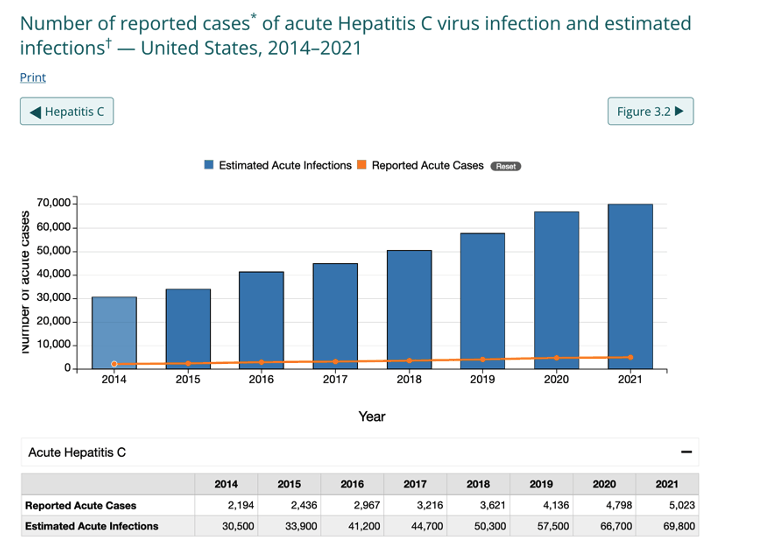
A total of 107,540 newly chronic hepatitis C cases were reported during 2021. A higher number of newly reported cases of chronic hepatitis C were observed among males, compared with females across all age groups. Among both males and females, a bimodal age distribution was observed with infections highest among persons aged 20-39 years and a second peak around 55-70 years.
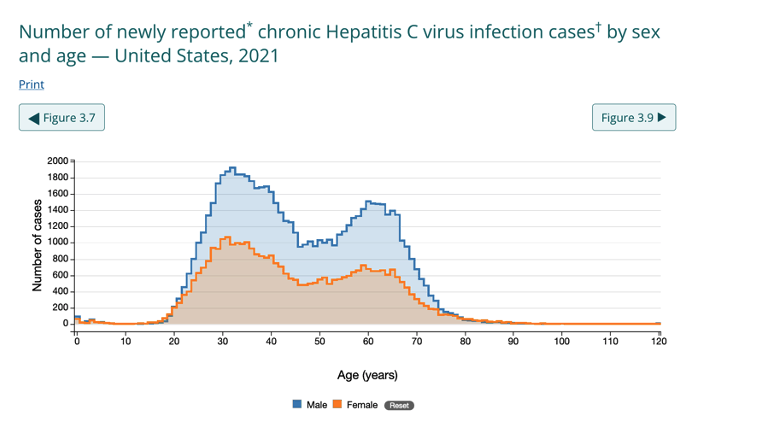
This table summarizes the epidemiology of acute hepatitis C in the United States. During 2021, rates of acute hepatitis C were highest among persons aged 20-49 years, males, non-Hispanic American Indian/Alaska Native persons, and those living in US Department of Health and Human Services Region 4 (Alabama, Florida, Georgia, Kentucky, Mississippi, North Carolina, South Carolina, and Tennessee).
Using urbanicity categories defined by the National Center for Health Statistics, from 2020-2021 the rates of reported cases of acute hepatitis C increased in urban settings, but in 2021 rates remained slightly higher in rural settings compared with urban settings. Among all acute hepatitis C cases reported during 2021, 52% occurred among persons aged 20-39 years, 68% occurred among non-Hispanic White persons, and 84% occurred in urban areas.
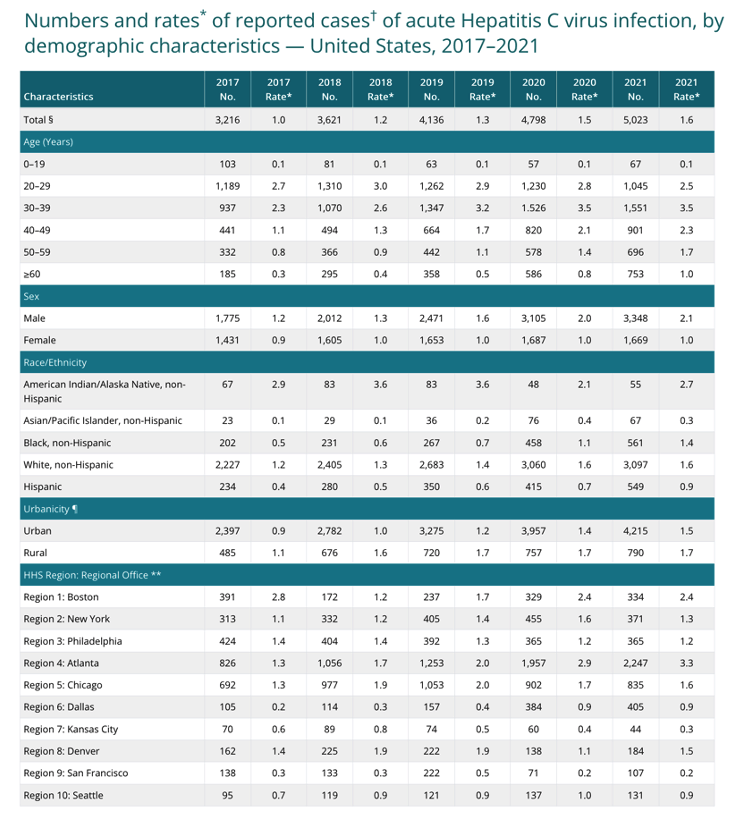

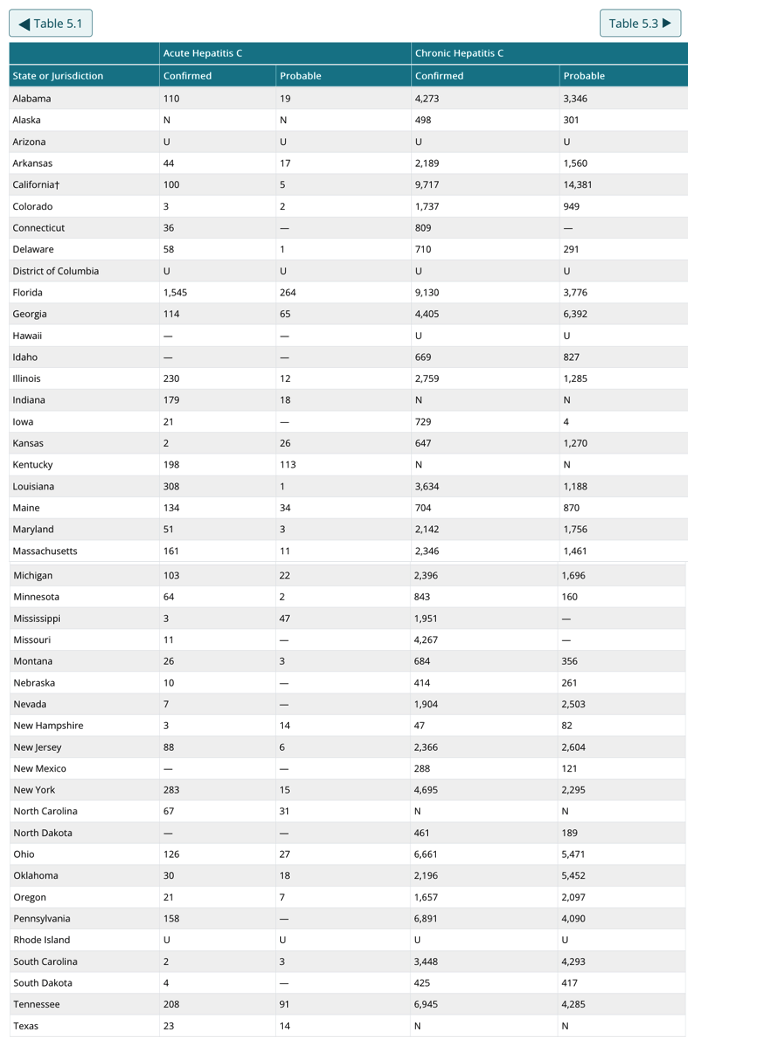

During 2021, the rates of reported acute hepatitis C ranged from a high of 9.8 cases per 100,000 population in Maine to a low of ≤0.1 or lesscases per 100,000 population in South Carolina, Colorado, Kansas, Mississippi, and Texas. The largest absolute increase in rates was observed in Utah, with a rate during 2021 of 4.5 cases per 100,000 population, at increase of 41% compared to the rate in 2020 of 3.2 cases per 100,000 population. The largest absolute decrease was observed in Maine, where the rate of 9.8 cases per 100,000 population in 2021 was an 18% decrease from the rate of 11.9 cases per 100,000 population in 2020. Because of the relatively smaller number of acute hepatitis C cases reported in certain jurisdictions, wide fluctuations in annual rates might occur.
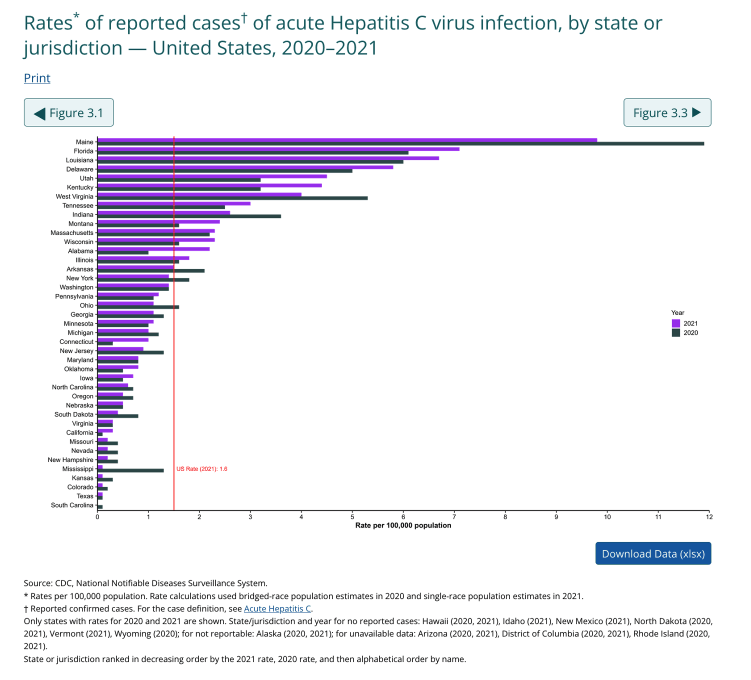
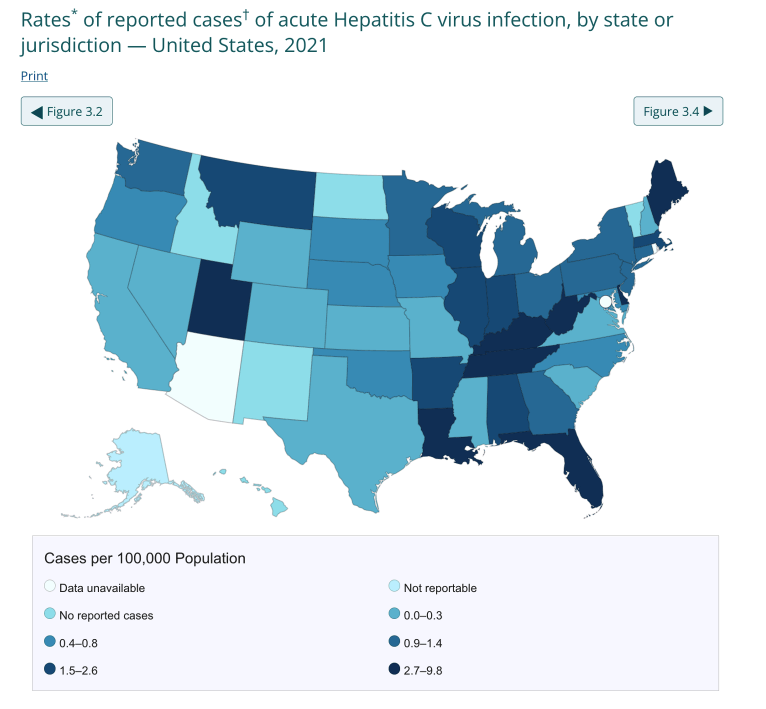
The capacity of each jurisdiction for notifying CDC of acute hepatitis C cases varies considerably on the basis of laws, resources, and infrastructure for conducting viral hepatitis surveillance. During 2021, acute hepatitis C was not a reportable condition in one state (Alaska), cases were unavailable from three states or jurisdictions (Arizona, District of Columbia, and Rhode Island), and no cases were reported by five states (Hawaii, Idaho, New Mexico, North Dakota, and Vermont).
The national rate of reported acute hepatitis C was 1.6 cases per 100,000 population during 2021, a 60% increase from the rate reported during 2017. During 2021, Maine had the highest rate of reported cases of acute hepatitis C (9.8 cases per 100,000 population), whereas Florida reported the largest number of cases (n = 1,545).
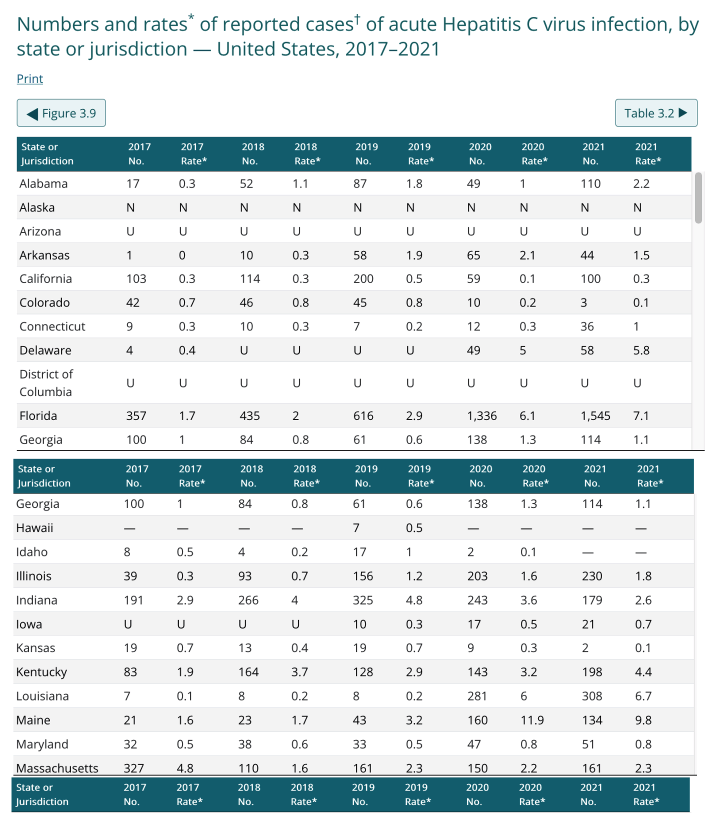
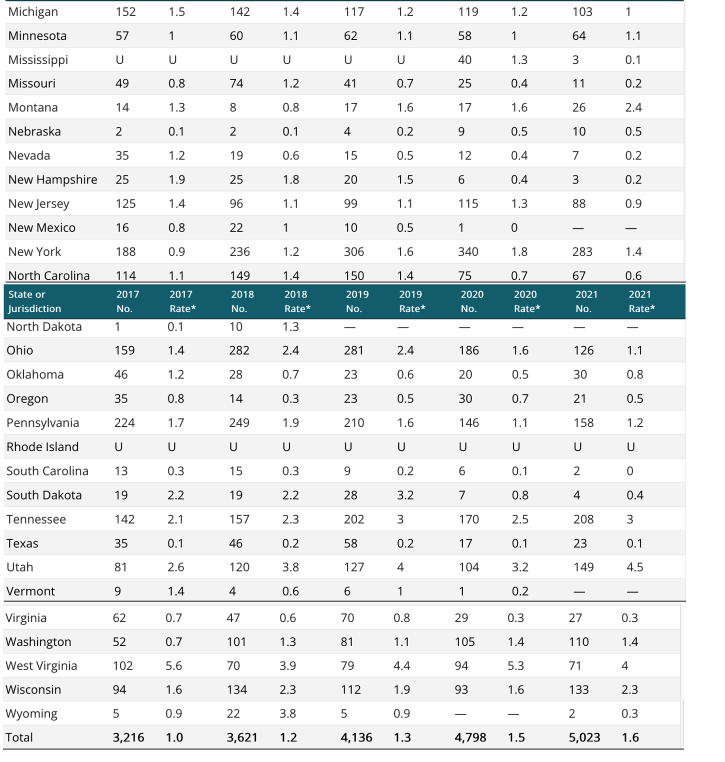
Rates have consistently been lowest among those aged less than 20 years or 60 years and older; however, rates have been increasing among those aged 60 years and older since 2016.
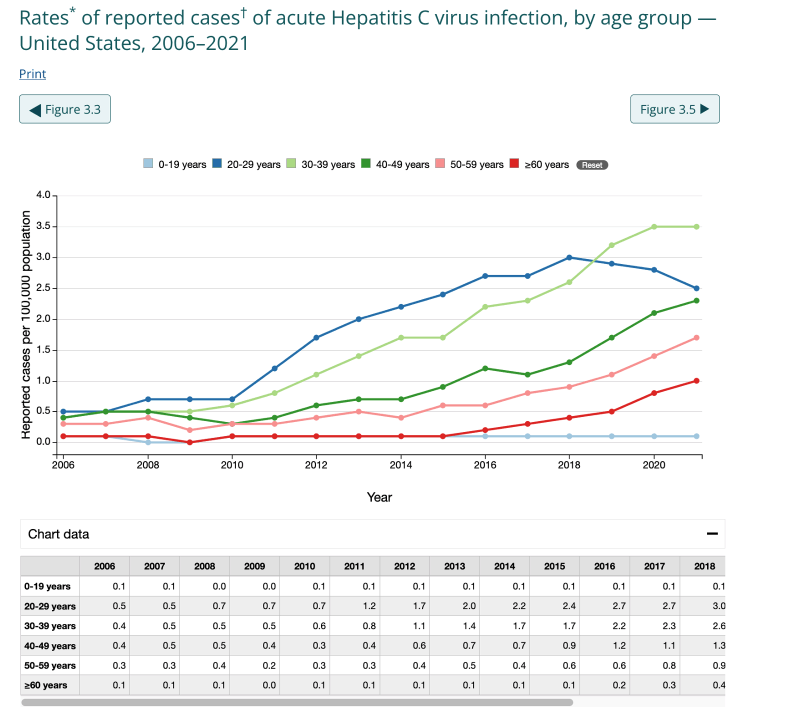
Compared with 2006, rates in 2021 were substantially higher among all race and ethnicity categories. During 2021, rates of reported cases of acute hepatitis C ranged from a low of 0.3 cases per 100,000 population among non-Hispanic Asian/Pacific Islander (A/PI) persons to a high of 2.7 cases per 100,000 population among non-Hispanic American Indian/Alaska Native persons. From 2020-2021, rates increased in all race and ethnicity categories, except among non-Hispanic A/PI. Variations of disease rates by race or ethnicity may reflect systemic cultural, behavioral, environmental, and social factors, including structural racism.
https://www.cdc.gov/hepatitis/statistics/2021surveillance/hepatitis-c/figure-3.6.htm
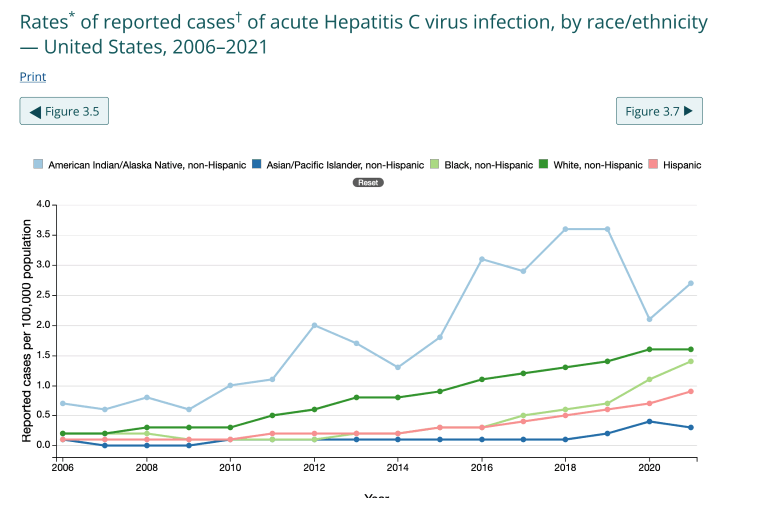
This table displays the number and rates of newly reported chronic hepatitis C cases during 2021, by state or jurisdiction. Health departments might not have adequate resources for investigating all cases reported in their jurisdiction. During 2021, chronic hepatitis C was not a reportable condition in four states (Indiana, Kentucky, North Carolina, and Texas), and cases were unavailable from four states or jurisdictions (Arizona, District of Columbia, Hawaii, and Rhode Island). Of note, cases of newly reported chronic hepatitis C do not represent all prevalent hepatitis C virus infections, which cannot be captured in the National Notifiable Diseases Surveillance System.
Of the 107,540 newly reported cases of chronic hepatitis C in 2021, the highest rate of newly reported cases of chronic hepatitis C was in West Virginia (151.4 cases per 100,000 population), followed by Tennessee (99.6 cases per 100,000 population), Alabama (84.8 cases per 100,000 population), Louisiana (78.6 cases per 100,000 population), and Arkansas (72.3 cases per 100,000 population).
Note: Delaware, Florida, Louisiana, Maine, Penn, So Car, NY.....
During 2021, state-specific mortality rates varied throughout the country but were highest in the Central, Western, and certain Appalachian states, which reflects a different epidemiologic picture from acute hepatitis C rates (Figure 3.3). The jurisdictions in the highest rate category of 4.67-11.05 deaths per 100,000 population include (in increasing rate order) Washington, Kentucky, Louisiana, Tennessee, Colorado, New Mexico, West Virginia, Oregon, District of Columbia, and Oklahoma. The states in the lowest rate category (0.00-2.06 deaths per 100,000 population) include Connecticut, Maine, New Jersey, Utah, Illinois, Hawaii, Wisconsin, Georgia, New Hampshire, New York, and Iowa.
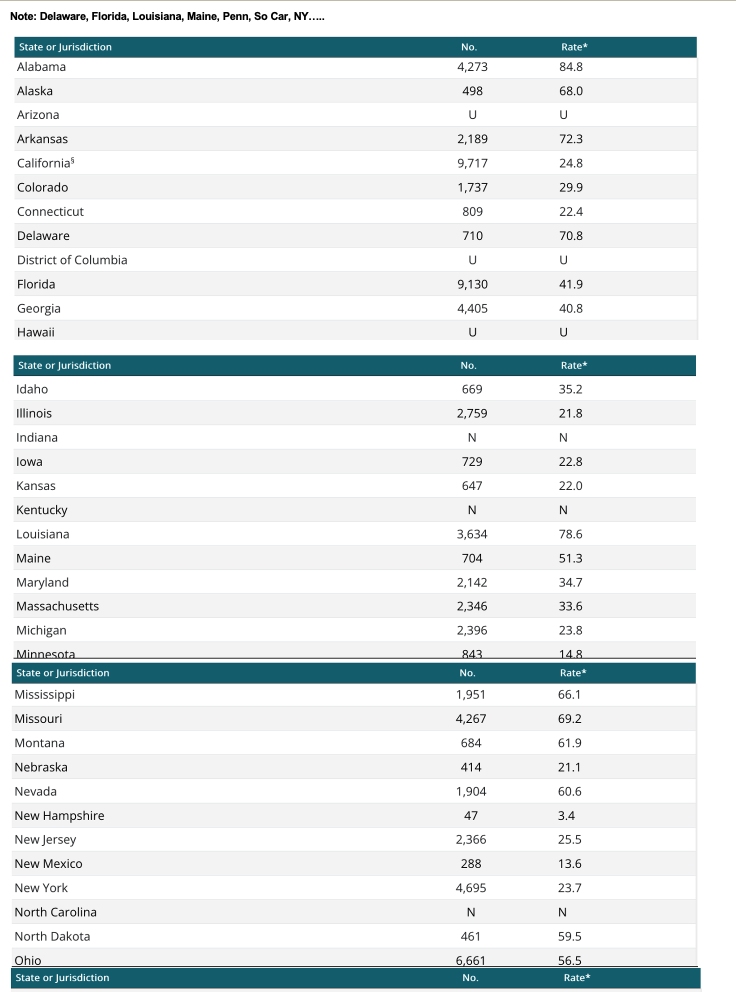
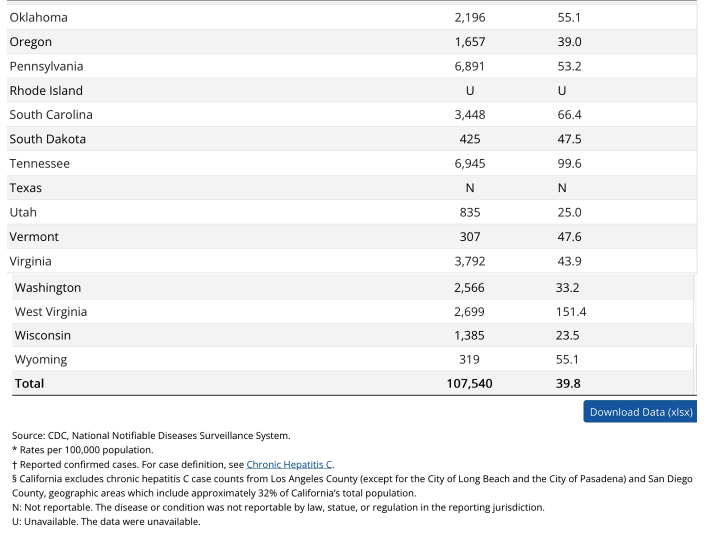
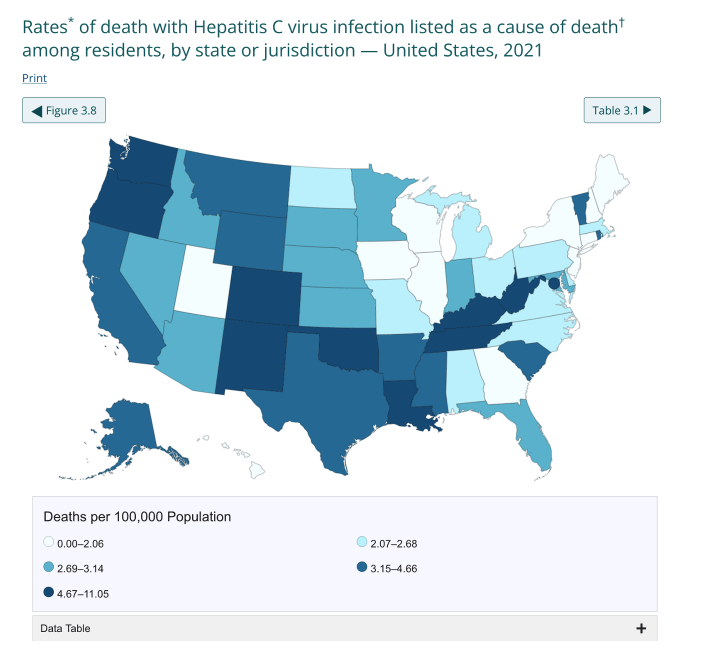
This table summarizes the characteristics of hepatitis C-associated deaths among residents in the United States. During 2021, a total of 13,895 hepatitis C-associated deaths were reported among US residents in the US Multiple Cause of Death data from the National Center for Health Statistics, resulting in an age-adjusted mortality rate of 3.18 deaths per 100,000 population.
Hepatitis C-associated death rates were highest among persons aged 55-74 years, compared with other age categories, and deaths in this age group accounted for 75% of all hepatitis C-associated deaths reported during 2021. Non-Hispanic White persons accounted for 63% of all hepatitis C-listed deaths with a rate of 2.98 deaths per 100,000 population; however, the death rates among non-Hispanic American Indian/Alaska Native persons (9.99 deaths per 100,000 population) and non-Hispanic Black persons (5.01 deaths per 100,000 population) were 3.4 times and 1.7 times the rate among non-Hispanic White persons, respectively. Variations of disease rates by race or ethnicity may reflect systemic cultural, behavioral, environmental, and social factors, including structural racism. The highest hepatitis C-associated death rate was reported in US Department of Health and Human Services Region 10 (Alaska, Idaho, Oregon, and Washington), compared with other regions.
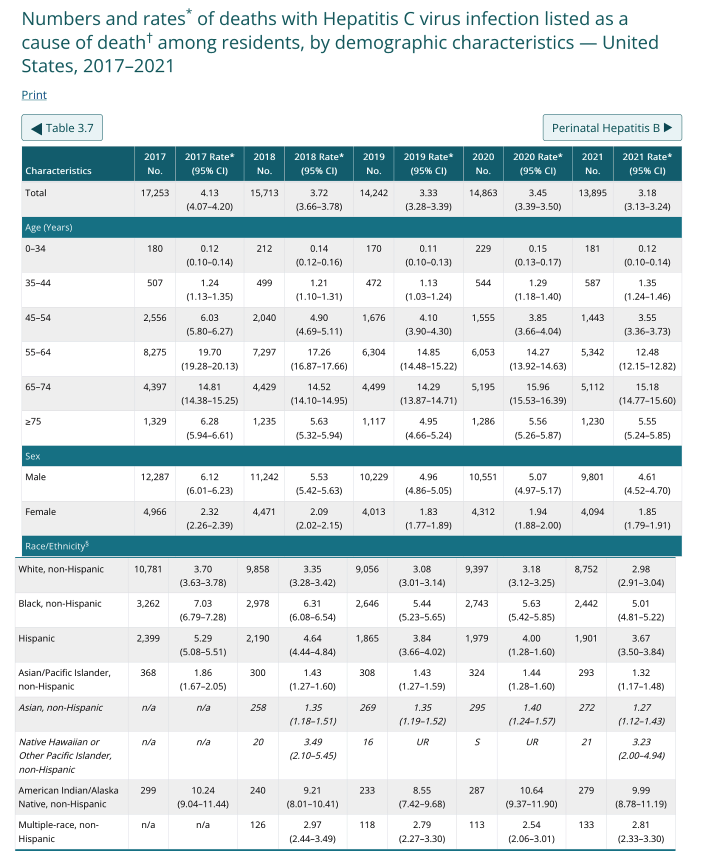
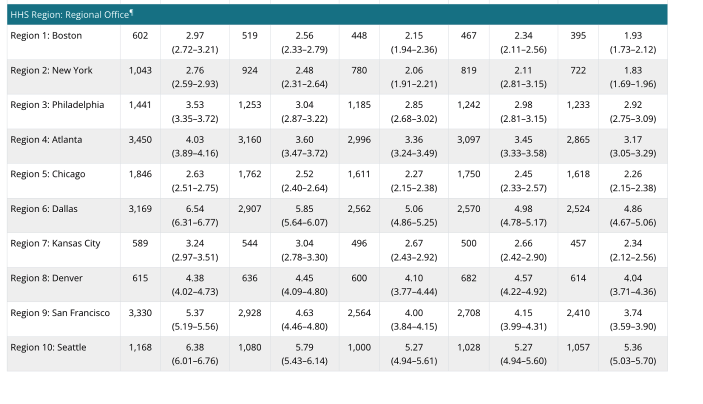
| |
| |
| |
|
|
|